Business and Business Environment Report: JLP, Org Types, and Analysis
VerifiedAdded on 2020/12/18
|15
|4217
|62
Report
AI Summary
This report provides a detailed analysis of the business environment, using John Lewis Partnership (JLP) as a case study. It begins with an introduction to the business environment, defining both external and internal factors, and then provides an overview of different organizational types, including private, public, and voluntary organizations, with examples such as JLP, British Petroleum, and Wellcome Trust. The report delves into the background details of these organizations, including their size, scope, products, services, vision, mission, and objectives. It further explores the organizational and legal structures, along with stakeholder information for each company. A significant portion of the report focuses on the functions of organizations and their interrelationships, such as purchasing and production, marketing and human resources, and the relationship between sales and finance, highlighting how these interdependencies contribute to achieving organizational objectives. Finally, the report includes an analysis of the macro factors affecting the chosen organization and the internal and external analysis, along with a SWOT analysis to assess strengths, weaknesses, opportunities, and threats, concluding with a summary of the key findings.
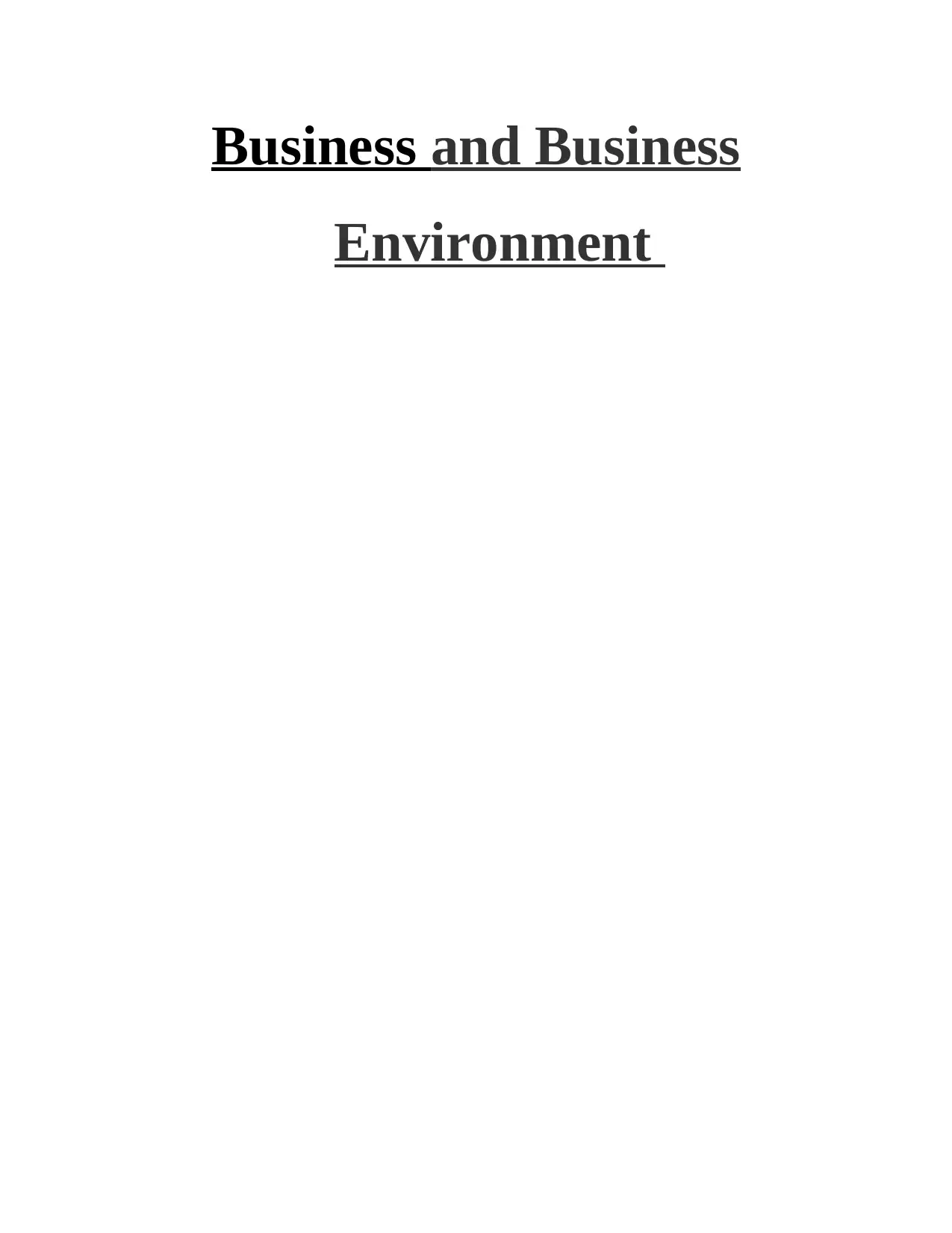
Business and Business
Environment
Environment
Paraphrase This Document
Need a fresh take? Get an instant paraphrase of this document with our AI Paraphraser
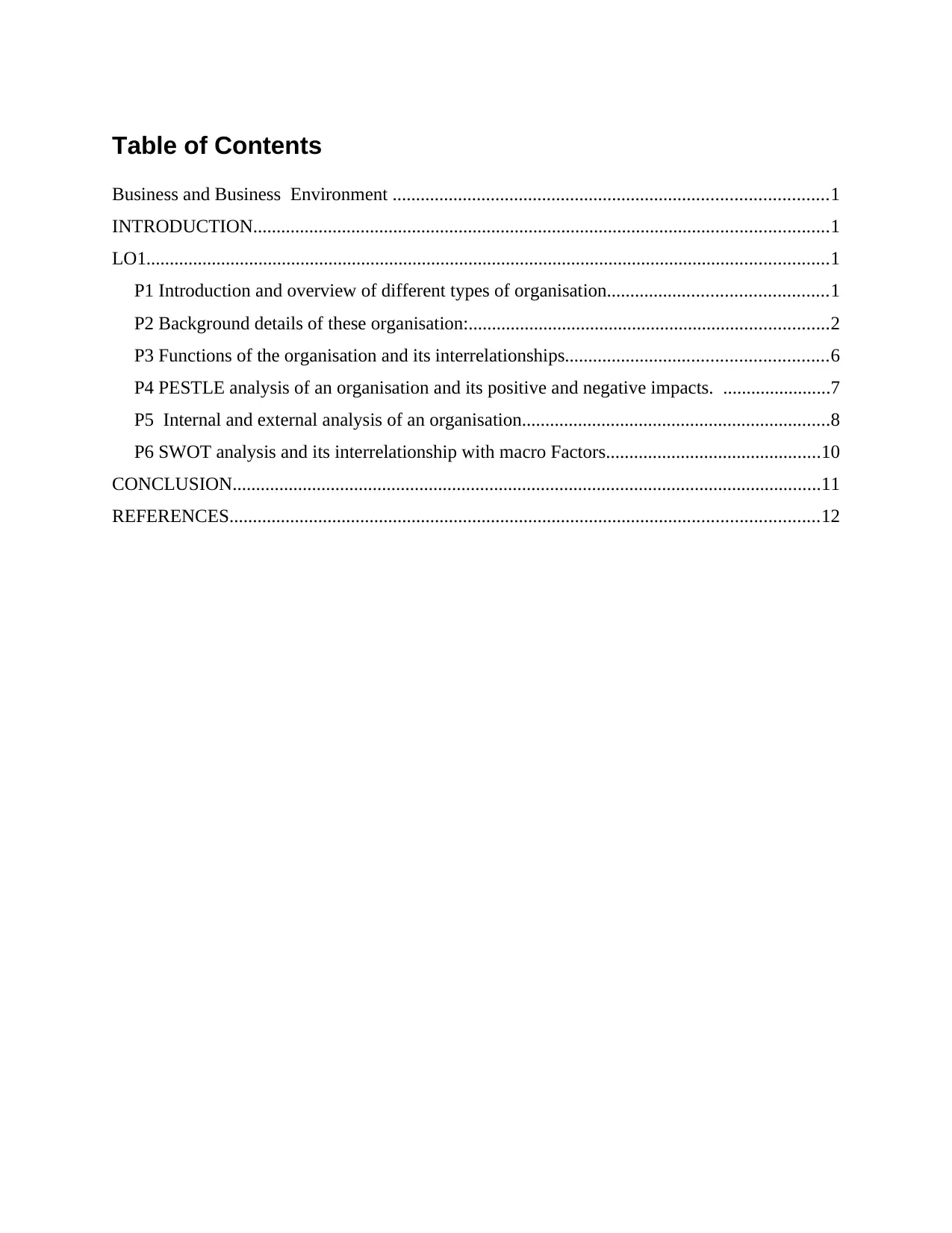
Table of Contents
Business and Business Environment .............................................................................................1
INTRODUCTION...........................................................................................................................1
LO1..................................................................................................................................................1
P1 Introduction and overview of different types of organisation...............................................1
P2 Background details of these organisation:.............................................................................2
P3 Functions of the organisation and its interrelationships........................................................6
P4 PESTLE analysis of an organisation and its positive and negative impacts. .......................7
P5 Internal and external analysis of an organisation..................................................................8
P6 SWOT analysis and its interrelationship with macro Factors..............................................10
CONCLUSION..............................................................................................................................11
REFERENCES..............................................................................................................................12
Business and Business Environment .............................................................................................1
INTRODUCTION...........................................................................................................................1
LO1..................................................................................................................................................1
P1 Introduction and overview of different types of organisation...............................................1
P2 Background details of these organisation:.............................................................................2
P3 Functions of the organisation and its interrelationships........................................................6
P4 PESTLE analysis of an organisation and its positive and negative impacts. .......................7
P5 Internal and external analysis of an organisation..................................................................8
P6 SWOT analysis and its interrelationship with macro Factors..............................................10
CONCLUSION..............................................................................................................................11
REFERENCES..............................................................................................................................12
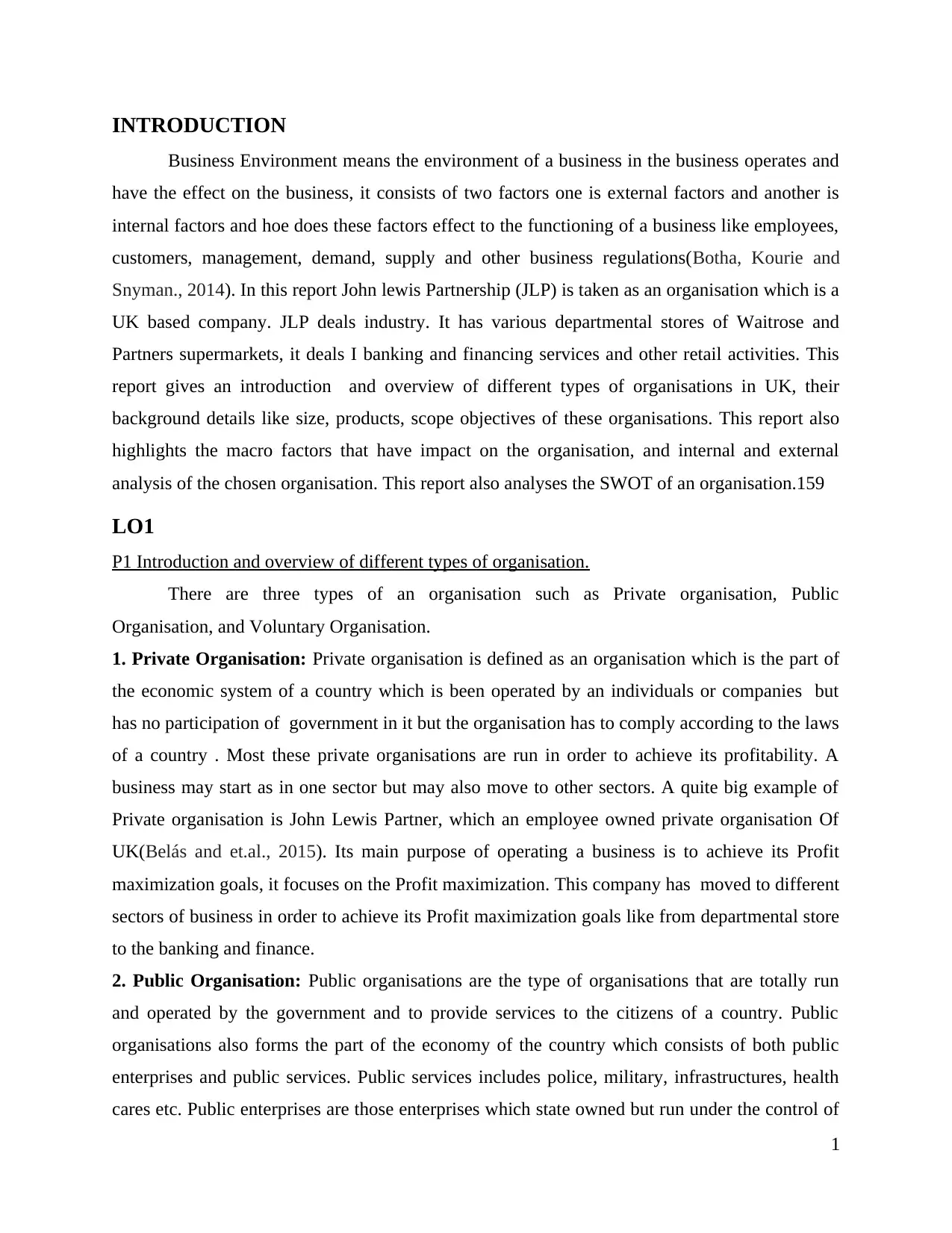
INTRODUCTION
Business Environment means the environment of a business in the business operates and
have the effect on the business, it consists of two factors one is external factors and another is
internal factors and hoe does these factors effect to the functioning of a business like employees,
customers, management, demand, supply and other business regulations(Botha, Kourie and
Snyman., 2014). In this report John lewis Partnership (JLP) is taken as an organisation which is a
UK based company. JLP deals industry. It has various departmental stores of Waitrose and
Partners supermarkets, it deals I banking and financing services and other retail activities. This
report gives an introduction and overview of different types of organisations in UK, their
background details like size, products, scope objectives of these organisations. This report also
highlights the macro factors that have impact on the organisation, and internal and external
analysis of the chosen organisation. This report also analyses the SWOT of an organisation.159
LO1
P1 Introduction and overview of different types of organisation.
There are three types of an organisation such as Private organisation, Public
Organisation, and Voluntary Organisation.
1. Private Organisation: Private organisation is defined as an organisation which is the part of
the economic system of a country which is been operated by an individuals or companies but
has no participation of government in it but the organisation has to comply according to the laws
of a country . Most these private organisations are run in order to achieve its profitability. A
business may start as in one sector but may also move to other sectors. A quite big example of
Private organisation is John Lewis Partner, which an employee owned private organisation Of
UK(Belás and et.al., 2015). Its main purpose of operating a business is to achieve its Profit
maximization goals, it focuses on the Profit maximization. This company has moved to different
sectors of business in order to achieve its Profit maximization goals like from departmental store
to the banking and finance.
2. Public Organisation: Public organisations are the type of organisations that are totally run
and operated by the government and to provide services to the citizens of a country. Public
organisations also forms the part of the economy of the country which consists of both public
enterprises and public services. Public services includes police, military, infrastructures, health
cares etc. Public enterprises are those enterprises which state owned but run under the control of
1
Business Environment means the environment of a business in the business operates and
have the effect on the business, it consists of two factors one is external factors and another is
internal factors and hoe does these factors effect to the functioning of a business like employees,
customers, management, demand, supply and other business regulations(Botha, Kourie and
Snyman., 2014). In this report John lewis Partnership (JLP) is taken as an organisation which is a
UK based company. JLP deals industry. It has various departmental stores of Waitrose and
Partners supermarkets, it deals I banking and financing services and other retail activities. This
report gives an introduction and overview of different types of organisations in UK, their
background details like size, products, scope objectives of these organisations. This report also
highlights the macro factors that have impact on the organisation, and internal and external
analysis of the chosen organisation. This report also analyses the SWOT of an organisation.159
LO1
P1 Introduction and overview of different types of organisation.
There are three types of an organisation such as Private organisation, Public
Organisation, and Voluntary Organisation.
1. Private Organisation: Private organisation is defined as an organisation which is the part of
the economic system of a country which is been operated by an individuals or companies but
has no participation of government in it but the organisation has to comply according to the laws
of a country . Most these private organisations are run in order to achieve its profitability. A
business may start as in one sector but may also move to other sectors. A quite big example of
Private organisation is John Lewis Partner, which an employee owned private organisation Of
UK(Belás and et.al., 2015). Its main purpose of operating a business is to achieve its Profit
maximization goals, it focuses on the Profit maximization. This company has moved to different
sectors of business in order to achieve its Profit maximization goals like from departmental store
to the banking and finance.
2. Public Organisation: Public organisations are the type of organisations that are totally run
and operated by the government and to provide services to the citizens of a country. Public
organisations also forms the part of the economy of the country which consists of both public
enterprises and public services. Public services includes police, military, infrastructures, health
cares etc. Public enterprises are those enterprises which state owned but run under the control of
1
⊘ This is a preview!⊘
Do you want full access?
Subscribe today to unlock all pages.

Trusted by 1+ million students worldwide
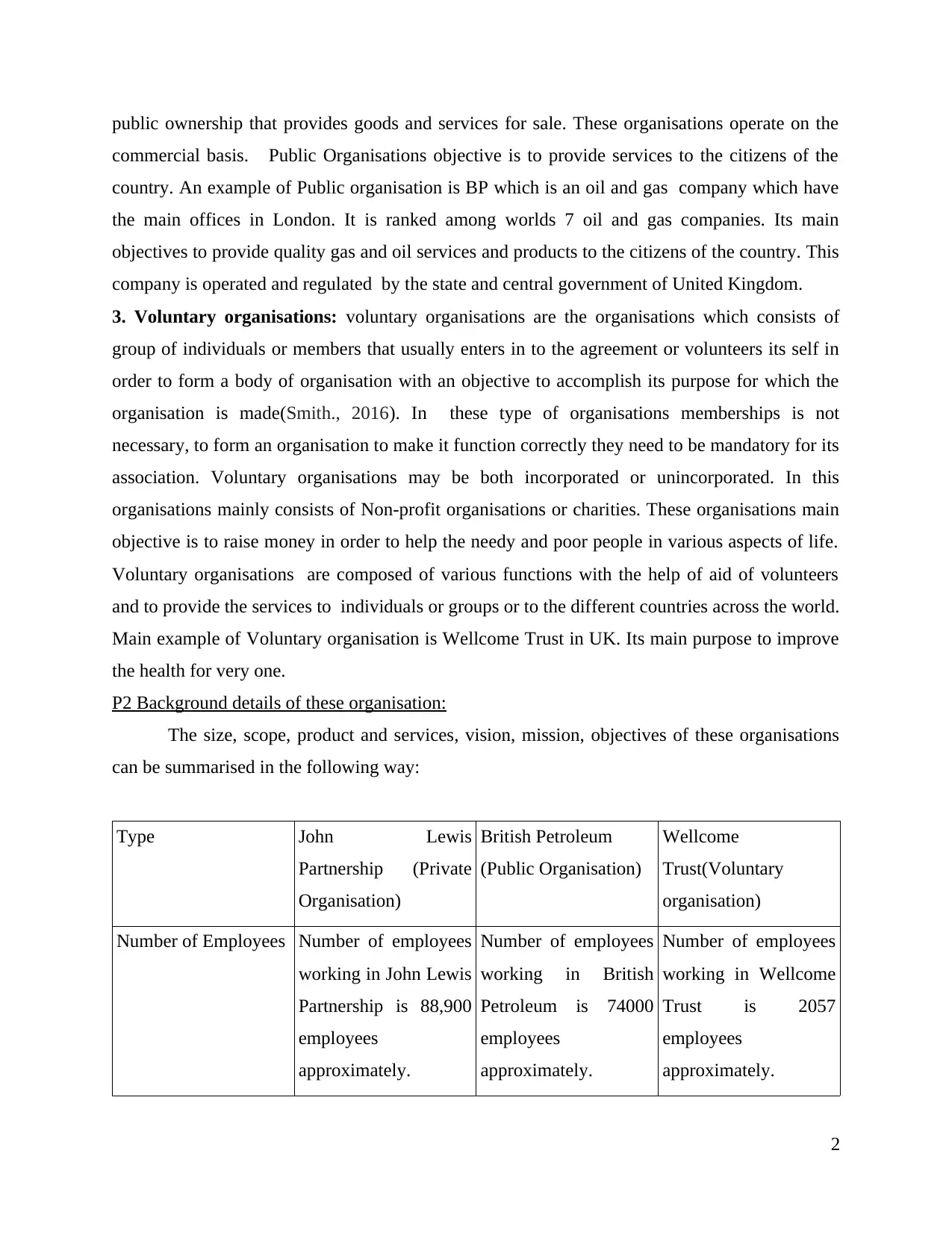
public ownership that provides goods and services for sale. These organisations operate on the
commercial basis. Public Organisations objective is to provide services to the citizens of the
country. An example of Public organisation is BP which is an oil and gas company which have
the main offices in London. It is ranked among worlds 7 oil and gas companies. Its main
objectives to provide quality gas and oil services and products to the citizens of the country. This
company is operated and regulated by the state and central government of United Kingdom.
3. Voluntary organisations: voluntary organisations are the organisations which consists of
group of individuals or members that usually enters in to the agreement or volunteers its self in
order to form a body of organisation with an objective to accomplish its purpose for which the
organisation is made(Smith., 2016). In these type of organisations memberships is not
necessary, to form an organisation to make it function correctly they need to be mandatory for its
association. Voluntary organisations may be both incorporated or unincorporated. In this
organisations mainly consists of Non-profit organisations or charities. These organisations main
objective is to raise money in order to help the needy and poor people in various aspects of life.
Voluntary organisations are composed of various functions with the help of aid of volunteers
and to provide the services to individuals or groups or to the different countries across the world.
Main example of Voluntary organisation is Wellcome Trust in UK. Its main purpose to improve
the health for very one.
P2 Background details of these organisation:
The size, scope, product and services, vision, mission, objectives of these organisations
can be summarised in the following way:
Type John Lewis
Partnership (Private
Organisation)
British Petroleum
(Public Organisation)
Wellcome
Trust(Voluntary
organisation)
Number of Employees Number of employees
working in John Lewis
Partnership is 88,900
employees
approximately.
Number of employees
working in British
Petroleum is 74000
employees
approximately.
Number of employees
working in Wellcome
Trust is 2057
employees
approximately.
2
commercial basis. Public Organisations objective is to provide services to the citizens of the
country. An example of Public organisation is BP which is an oil and gas company which have
the main offices in London. It is ranked among worlds 7 oil and gas companies. Its main
objectives to provide quality gas and oil services and products to the citizens of the country. This
company is operated and regulated by the state and central government of United Kingdom.
3. Voluntary organisations: voluntary organisations are the organisations which consists of
group of individuals or members that usually enters in to the agreement or volunteers its self in
order to form a body of organisation with an objective to accomplish its purpose for which the
organisation is made(Smith., 2016). In these type of organisations memberships is not
necessary, to form an organisation to make it function correctly they need to be mandatory for its
association. Voluntary organisations may be both incorporated or unincorporated. In this
organisations mainly consists of Non-profit organisations or charities. These organisations main
objective is to raise money in order to help the needy and poor people in various aspects of life.
Voluntary organisations are composed of various functions with the help of aid of volunteers
and to provide the services to individuals or groups or to the different countries across the world.
Main example of Voluntary organisation is Wellcome Trust in UK. Its main purpose to improve
the health for very one.
P2 Background details of these organisation:
The size, scope, product and services, vision, mission, objectives of these organisations
can be summarised in the following way:
Type John Lewis
Partnership (Private
Organisation)
British Petroleum
(Public Organisation)
Wellcome
Trust(Voluntary
organisation)
Number of Employees Number of employees
working in John Lewis
Partnership is 88,900
employees
approximately.
Number of employees
working in British
Petroleum is 74000
employees
approximately.
Number of employees
working in Wellcome
Trust is 2057
employees
approximately.
2
Paraphrase This Document
Need a fresh take? Get an instant paraphrase of this document with our AI Paraphraser
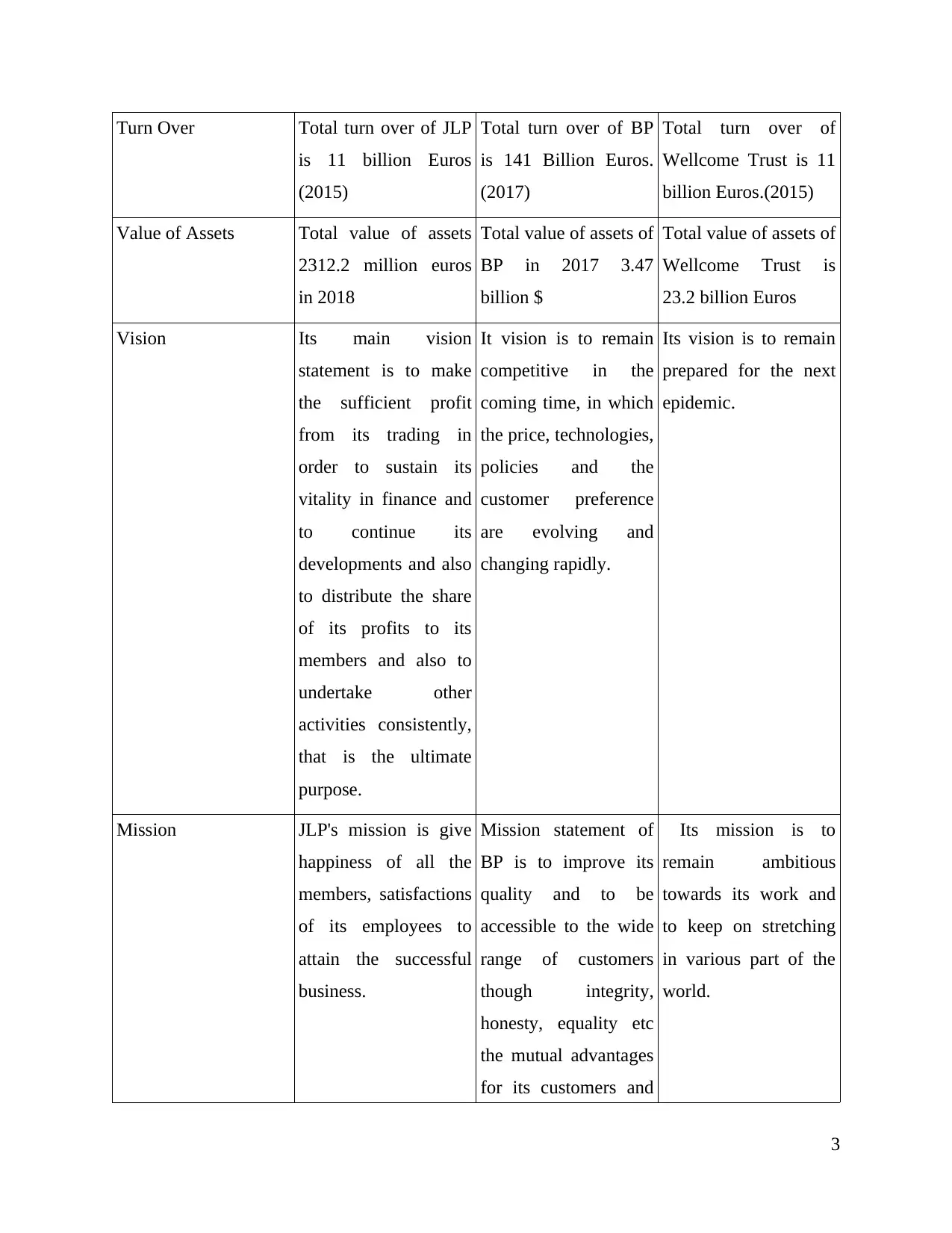
Turn Over Total turn over of JLP
is 11 billion Euros
(2015)
Total turn over of BP
is 141 Billion Euros.
(2017)
Total turn over of
Wellcome Trust is 11
billion Euros.(2015)
Value of Assets Total value of assets
2312.2 million euros
in 2018
Total value of assets of
BP in 2017 3.47
billion $
Total value of assets of
Wellcome Trust is
23.2 billion Euros
Vision Its main vision
statement is to make
the sufficient profit
from its trading in
order to sustain its
vitality in finance and
to continue its
developments and also
to distribute the share
of its profits to its
members and also to
undertake other
activities consistently,
that is the ultimate
purpose.
It vision is to remain
competitive in the
coming time, in which
the price, technologies,
policies and the
customer preference
are evolving and
changing rapidly.
Its vision is to remain
prepared for the next
epidemic.
Mission JLP's mission is give
happiness of all the
members, satisfactions
of its employees to
attain the successful
business.
Mission statement of
BP is to improve its
quality and to be
accessible to the wide
range of customers
though integrity,
honesty, equality etc
the mutual advantages
for its customers and
Its mission is to
remain ambitious
towards its work and
to keep on stretching
in various part of the
world.
3
is 11 billion Euros
(2015)
Total turn over of BP
is 141 Billion Euros.
(2017)
Total turn over of
Wellcome Trust is 11
billion Euros.(2015)
Value of Assets Total value of assets
2312.2 million euros
in 2018
Total value of assets of
BP in 2017 3.47
billion $
Total value of assets of
Wellcome Trust is
23.2 billion Euros
Vision Its main vision
statement is to make
the sufficient profit
from its trading in
order to sustain its
vitality in finance and
to continue its
developments and also
to distribute the share
of its profits to its
members and also to
undertake other
activities consistently,
that is the ultimate
purpose.
It vision is to remain
competitive in the
coming time, in which
the price, technologies,
policies and the
customer preference
are evolving and
changing rapidly.
Its vision is to remain
prepared for the next
epidemic.
Mission JLP's mission is give
happiness of all the
members, satisfactions
of its employees to
attain the successful
business.
Mission statement of
BP is to improve its
quality and to be
accessible to the wide
range of customers
though integrity,
honesty, equality etc
the mutual advantages
for its customers and
Its mission is to
remain ambitious
towards its work and
to keep on stretching
in various part of the
world.
3
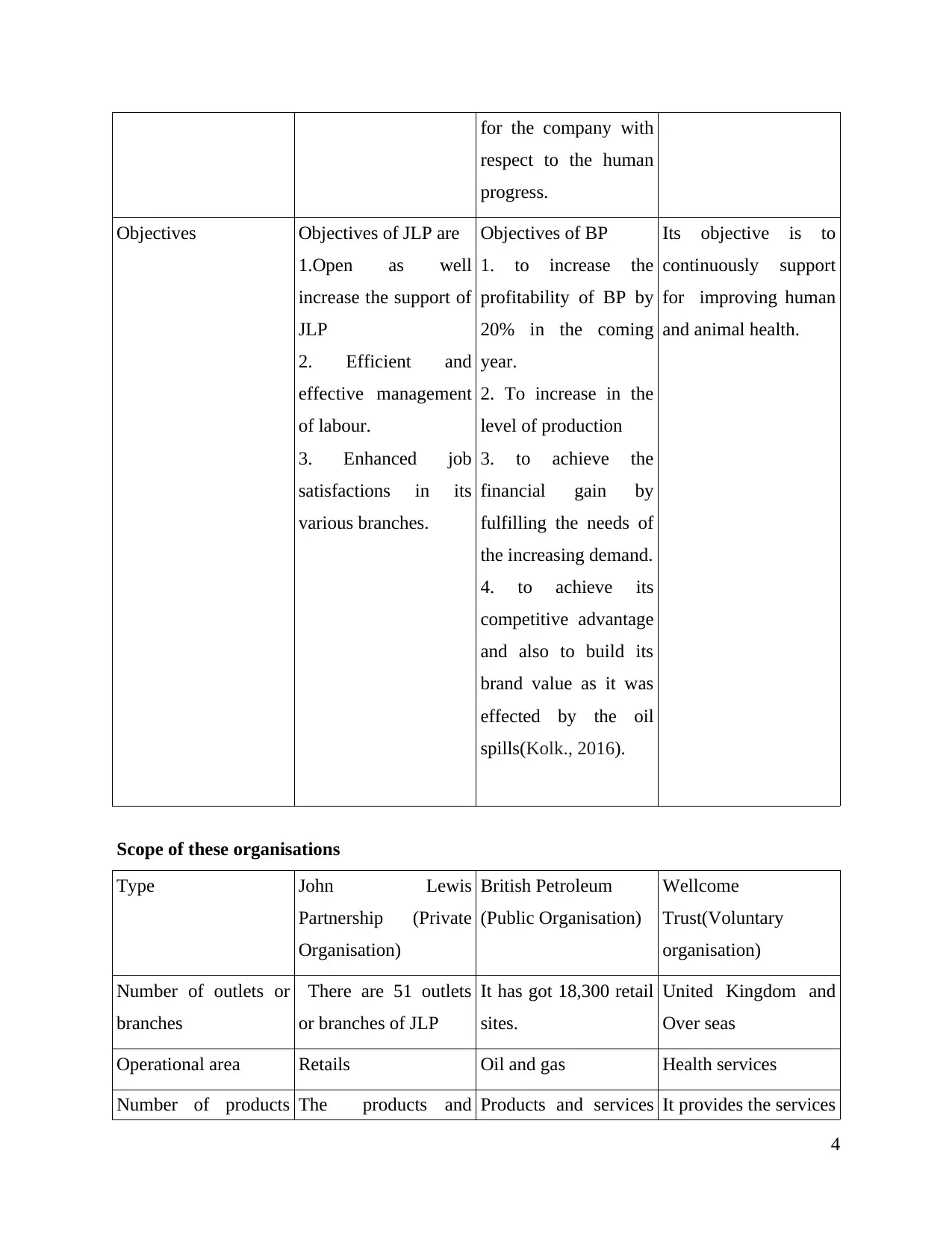
for the company with
respect to the human
progress.
Objectives Objectives of JLP are
1.Open as well
increase the support of
JLP
2. Efficient and
effective management
of labour.
3. Enhanced job
satisfactions in its
various branches.
Objectives of BP
1. to increase the
profitability of BP by
20% in the coming
year.
2. To increase in the
level of production
3. to achieve the
financial gain by
fulfilling the needs of
the increasing demand.
4. to achieve its
competitive advantage
and also to build its
brand value as it was
effected by the oil
spills(Kolk., 2016).
Its objective is to
continuously support
for improving human
and animal health.
Scope of these organisations
Type John Lewis
Partnership (Private
Organisation)
British Petroleum
(Public Organisation)
Wellcome
Trust(Voluntary
organisation)
Number of outlets or
branches
There are 51 outlets
or branches of JLP
It has got 18,300 retail
sites.
United Kingdom and
Over seas
Operational area Retails Oil and gas Health services
Number of products The products and Products and services It provides the services
4
respect to the human
progress.
Objectives Objectives of JLP are
1.Open as well
increase the support of
JLP
2. Efficient and
effective management
of labour.
3. Enhanced job
satisfactions in its
various branches.
Objectives of BP
1. to increase the
profitability of BP by
20% in the coming
year.
2. To increase in the
level of production
3. to achieve the
financial gain by
fulfilling the needs of
the increasing demand.
4. to achieve its
competitive advantage
and also to build its
brand value as it was
effected by the oil
spills(Kolk., 2016).
Its objective is to
continuously support
for improving human
and animal health.
Scope of these organisations
Type John Lewis
Partnership (Private
Organisation)
British Petroleum
(Public Organisation)
Wellcome
Trust(Voluntary
organisation)
Number of outlets or
branches
There are 51 outlets
or branches of JLP
It has got 18,300 retail
sites.
United Kingdom and
Over seas
Operational area Retails Oil and gas Health services
Number of products The products and Products and services It provides the services
4
⊘ This is a preview!⊘
Do you want full access?
Subscribe today to unlock all pages.

Trusted by 1+ million students worldwide
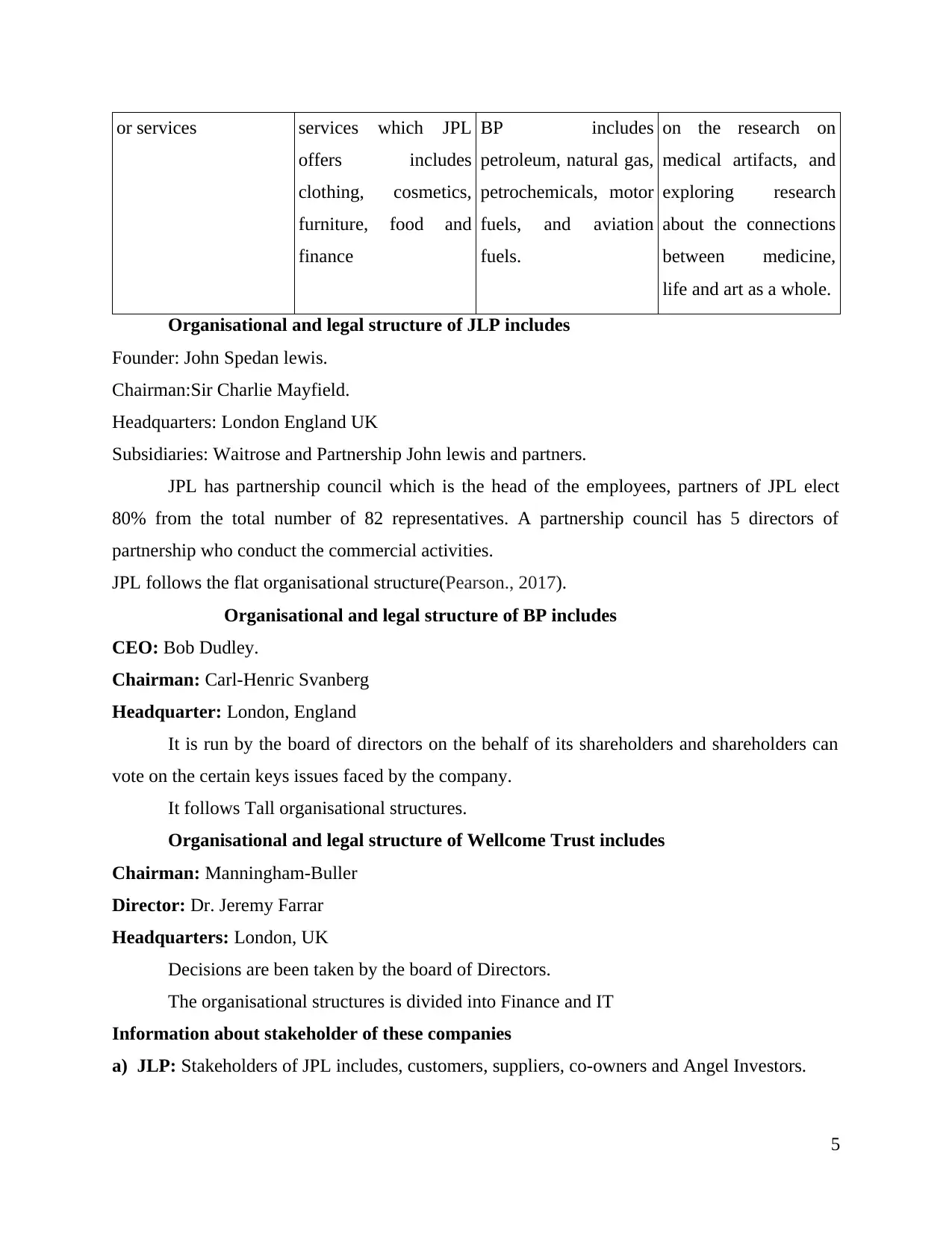
or services services which JPL
offers includes
clothing, cosmetics,
furniture, food and
finance
BP includes
petroleum, natural gas,
petrochemicals, motor
fuels, and aviation
fuels.
on the research on
medical artifacts, and
exploring research
about the connections
between medicine,
life and art as a whole.
Organisational and legal structure of JLP includes
Founder: John Spedan lewis.
Chairman:Sir Charlie Mayfield.
Headquarters: London England UK
Subsidiaries: Waitrose and Partnership John lewis and partners.
JPL has partnership council which is the head of the employees, partners of JPL elect
80% from the total number of 82 representatives. A partnership council has 5 directors of
partnership who conduct the commercial activities.
JPL follows the flat organisational structure(Pearson., 2017).
Organisational and legal structure of BP includes
CEO: Bob Dudley.
Chairman: Carl-Henric Svanberg
Headquarter: London, England
It is run by the board of directors on the behalf of its shareholders and shareholders can
vote on the certain keys issues faced by the company.
It follows Tall organisational structures.
Organisational and legal structure of Wellcome Trust includes
Chairman: Manningham-Buller
Director: Dr. Jeremy Farrar
Headquarters: London, UK
Decisions are been taken by the board of Directors.
The organisational structures is divided into Finance and IT
Information about stakeholder of these companies
a) JLP: Stakeholders of JPL includes, customers, suppliers, co-owners and Angel Investors.
5
offers includes
clothing, cosmetics,
furniture, food and
finance
BP includes
petroleum, natural gas,
petrochemicals, motor
fuels, and aviation
fuels.
on the research on
medical artifacts, and
exploring research
about the connections
between medicine,
life and art as a whole.
Organisational and legal structure of JLP includes
Founder: John Spedan lewis.
Chairman:Sir Charlie Mayfield.
Headquarters: London England UK
Subsidiaries: Waitrose and Partnership John lewis and partners.
JPL has partnership council which is the head of the employees, partners of JPL elect
80% from the total number of 82 representatives. A partnership council has 5 directors of
partnership who conduct the commercial activities.
JPL follows the flat organisational structure(Pearson., 2017).
Organisational and legal structure of BP includes
CEO: Bob Dudley.
Chairman: Carl-Henric Svanberg
Headquarter: London, England
It is run by the board of directors on the behalf of its shareholders and shareholders can
vote on the certain keys issues faced by the company.
It follows Tall organisational structures.
Organisational and legal structure of Wellcome Trust includes
Chairman: Manningham-Buller
Director: Dr. Jeremy Farrar
Headquarters: London, UK
Decisions are been taken by the board of Directors.
The organisational structures is divided into Finance and IT
Information about stakeholder of these companies
a) JLP: Stakeholders of JPL includes, customers, suppliers, co-owners and Angel Investors.
5
Paraphrase This Document
Need a fresh take? Get an instant paraphrase of this document with our AI Paraphraser
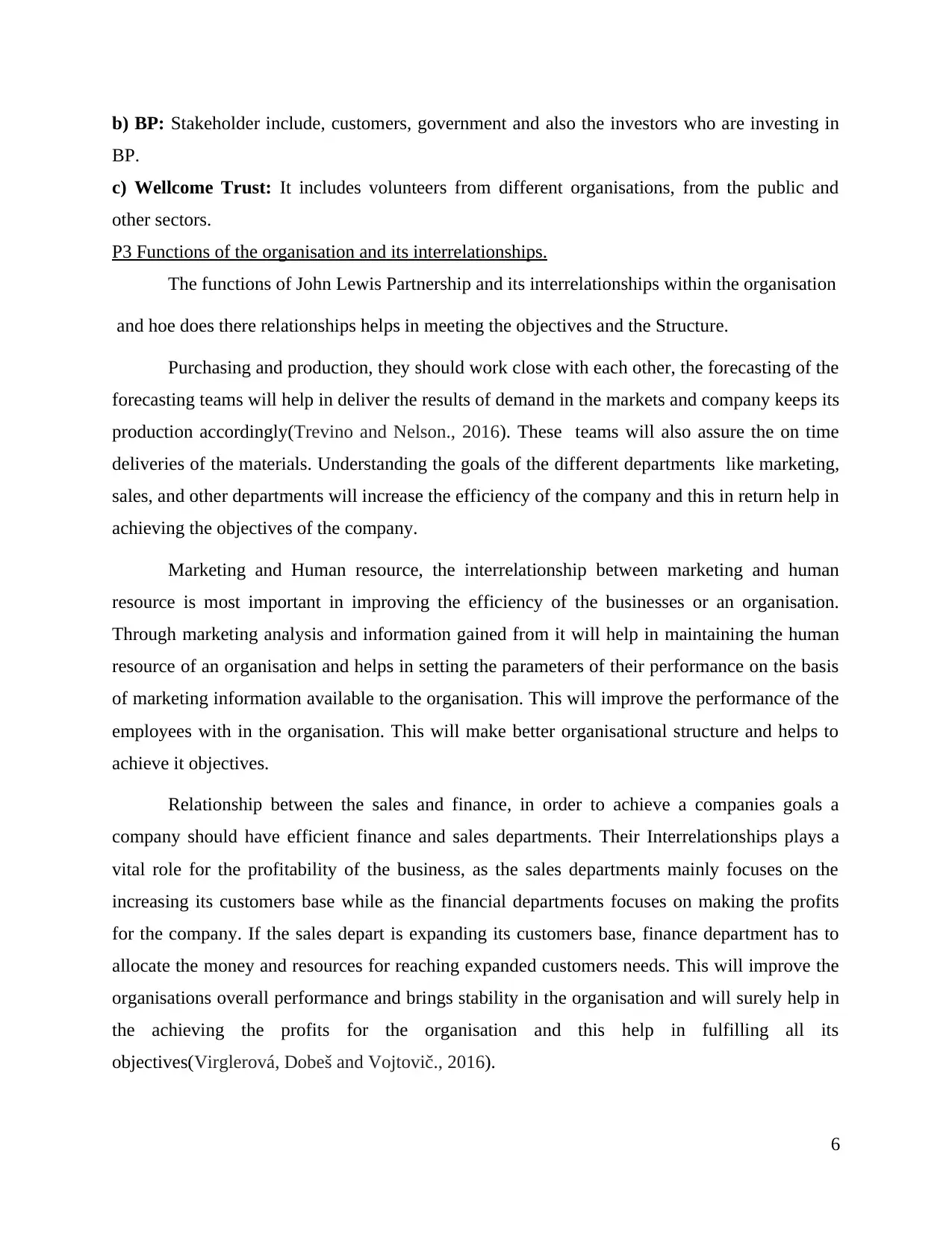
b) BP: Stakeholder include, customers, government and also the investors who are investing in
BP.
c) Wellcome Trust: It includes volunteers from different organisations, from the public and
other sectors.
P3 Functions of the organisation and its interrelationships.
The functions of John Lewis Partnership and its interrelationships within the organisation
and hoe does there relationships helps in meeting the objectives and the Structure.
Purchasing and production, they should work close with each other, the forecasting of the
forecasting teams will help in deliver the results of demand in the markets and company keeps its
production accordingly(Trevino and Nelson., 2016). These teams will also assure the on time
deliveries of the materials. Understanding the goals of the different departments like marketing,
sales, and other departments will increase the efficiency of the company and this in return help in
achieving the objectives of the company.
Marketing and Human resource, the interrelationship between marketing and human
resource is most important in improving the efficiency of the businesses or an organisation.
Through marketing analysis and information gained from it will help in maintaining the human
resource of an organisation and helps in setting the parameters of their performance on the basis
of marketing information available to the organisation. This will improve the performance of the
employees with in the organisation. This will make better organisational structure and helps to
achieve it objectives.
Relationship between the sales and finance, in order to achieve a companies goals a
company should have efficient finance and sales departments. Their Interrelationships plays a
vital role for the profitability of the business, as the sales departments mainly focuses on the
increasing its customers base while as the financial departments focuses on making the profits
for the company. If the sales depart is expanding its customers base, finance department has to
allocate the money and resources for reaching expanded customers needs. This will improve the
organisations overall performance and brings stability in the organisation and will surely help in
the achieving the profits for the organisation and this help in fulfilling all its
objectives(Virglerová, Dobeš and Vojtovič., 2016).
6
BP.
c) Wellcome Trust: It includes volunteers from different organisations, from the public and
other sectors.
P3 Functions of the organisation and its interrelationships.
The functions of John Lewis Partnership and its interrelationships within the organisation
and hoe does there relationships helps in meeting the objectives and the Structure.
Purchasing and production, they should work close with each other, the forecasting of the
forecasting teams will help in deliver the results of demand in the markets and company keeps its
production accordingly(Trevino and Nelson., 2016). These teams will also assure the on time
deliveries of the materials. Understanding the goals of the different departments like marketing,
sales, and other departments will increase the efficiency of the company and this in return help in
achieving the objectives of the company.
Marketing and Human resource, the interrelationship between marketing and human
resource is most important in improving the efficiency of the businesses or an organisation.
Through marketing analysis and information gained from it will help in maintaining the human
resource of an organisation and helps in setting the parameters of their performance on the basis
of marketing information available to the organisation. This will improve the performance of the
employees with in the organisation. This will make better organisational structure and helps to
achieve it objectives.
Relationship between the sales and finance, in order to achieve a companies goals a
company should have efficient finance and sales departments. Their Interrelationships plays a
vital role for the profitability of the business, as the sales departments mainly focuses on the
increasing its customers base while as the financial departments focuses on making the profits
for the company. If the sales depart is expanding its customers base, finance department has to
allocate the money and resources for reaching expanded customers needs. This will improve the
organisations overall performance and brings stability in the organisation and will surely help in
the achieving the profits for the organisation and this help in fulfilling all its
objectives(Virglerová, Dobeš and Vojtovič., 2016).
6
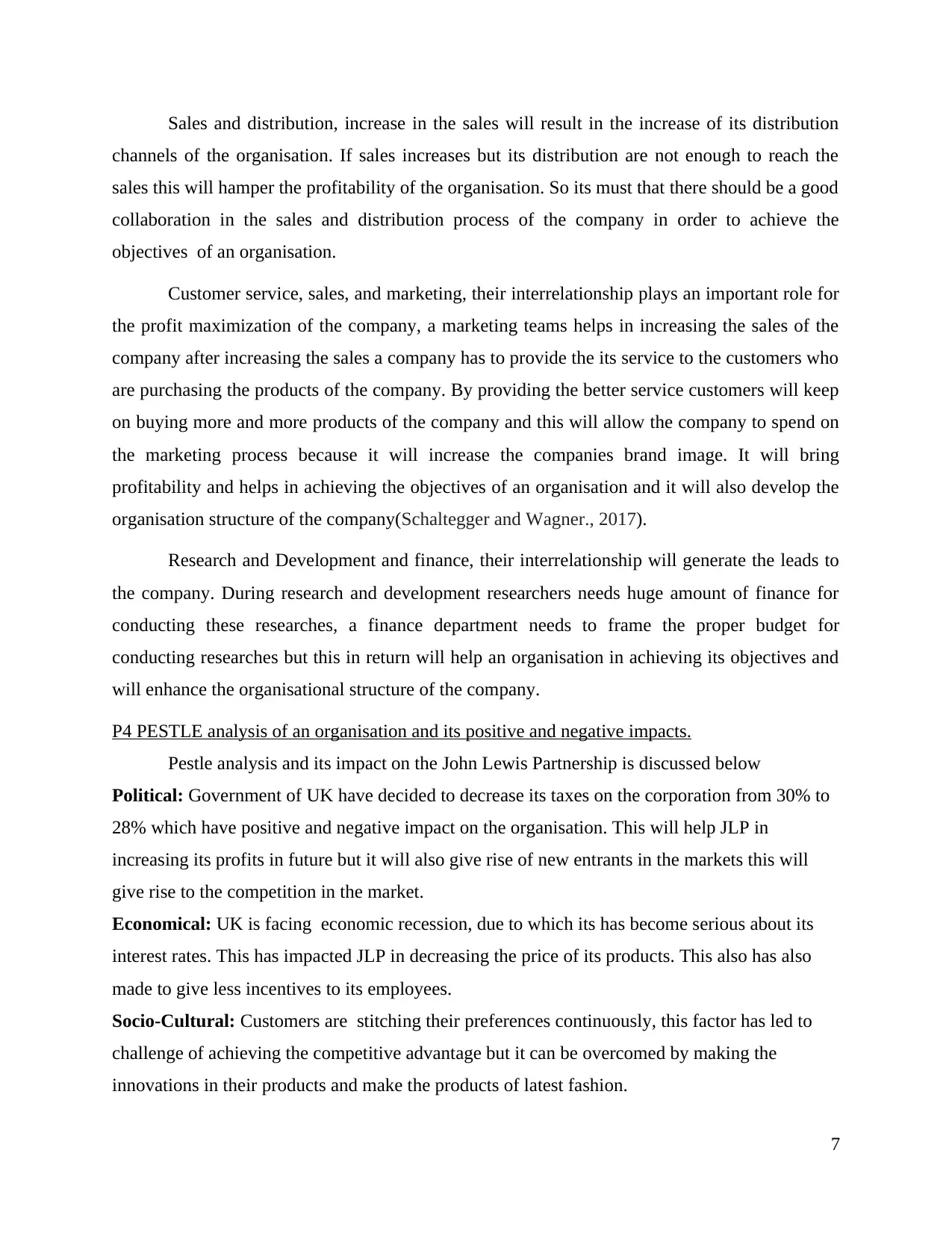
Sales and distribution, increase in the sales will result in the increase of its distribution
channels of the organisation. If sales increases but its distribution are not enough to reach the
sales this will hamper the profitability of the organisation. So its must that there should be a good
collaboration in the sales and distribution process of the company in order to achieve the
objectives of an organisation.
Customer service, sales, and marketing, their interrelationship plays an important role for
the profit maximization of the company, a marketing teams helps in increasing the sales of the
company after increasing the sales a company has to provide the its service to the customers who
are purchasing the products of the company. By providing the better service customers will keep
on buying more and more products of the company and this will allow the company to spend on
the marketing process because it will increase the companies brand image. It will bring
profitability and helps in achieving the objectives of an organisation and it will also develop the
organisation structure of the company(Schaltegger and Wagner., 2017).
Research and Development and finance, their interrelationship will generate the leads to
the company. During research and development researchers needs huge amount of finance for
conducting these researches, a finance department needs to frame the proper budget for
conducting researches but this in return will help an organisation in achieving its objectives and
will enhance the organisational structure of the company.
P4 PESTLE analysis of an organisation and its positive and negative impacts.
Pestle analysis and its impact on the John Lewis Partnership is discussed below
Political: Government of UK have decided to decrease its taxes on the corporation from 30% to
28% which have positive and negative impact on the organisation. This will help JLP in
increasing its profits in future but it will also give rise of new entrants in the markets this will
give rise to the competition in the market.
Economical: UK is facing economic recession, due to which its has become serious about its
interest rates. This has impacted JLP in decreasing the price of its products. This also has also
made to give less incentives to its employees.
Socio-Cultural: Customers are stitching their preferences continuously, this factor has led to
challenge of achieving the competitive advantage but it can be overcomed by making the
innovations in their products and make the products of latest fashion.
7
channels of the organisation. If sales increases but its distribution are not enough to reach the
sales this will hamper the profitability of the organisation. So its must that there should be a good
collaboration in the sales and distribution process of the company in order to achieve the
objectives of an organisation.
Customer service, sales, and marketing, their interrelationship plays an important role for
the profit maximization of the company, a marketing teams helps in increasing the sales of the
company after increasing the sales a company has to provide the its service to the customers who
are purchasing the products of the company. By providing the better service customers will keep
on buying more and more products of the company and this will allow the company to spend on
the marketing process because it will increase the companies brand image. It will bring
profitability and helps in achieving the objectives of an organisation and it will also develop the
organisation structure of the company(Schaltegger and Wagner., 2017).
Research and Development and finance, their interrelationship will generate the leads to
the company. During research and development researchers needs huge amount of finance for
conducting these researches, a finance department needs to frame the proper budget for
conducting researches but this in return will help an organisation in achieving its objectives and
will enhance the organisational structure of the company.
P4 PESTLE analysis of an organisation and its positive and negative impacts.
Pestle analysis and its impact on the John Lewis Partnership is discussed below
Political: Government of UK have decided to decrease its taxes on the corporation from 30% to
28% which have positive and negative impact on the organisation. This will help JLP in
increasing its profits in future but it will also give rise of new entrants in the markets this will
give rise to the competition in the market.
Economical: UK is facing economic recession, due to which its has become serious about its
interest rates. This has impacted JLP in decreasing the price of its products. This also has also
made to give less incentives to its employees.
Socio-Cultural: Customers are stitching their preferences continuously, this factor has led to
challenge of achieving the competitive advantage but it can be overcomed by making the
innovations in their products and make the products of latest fashion.
7
⊘ This is a preview!⊘
Do you want full access?
Subscribe today to unlock all pages.

Trusted by 1+ million students worldwide
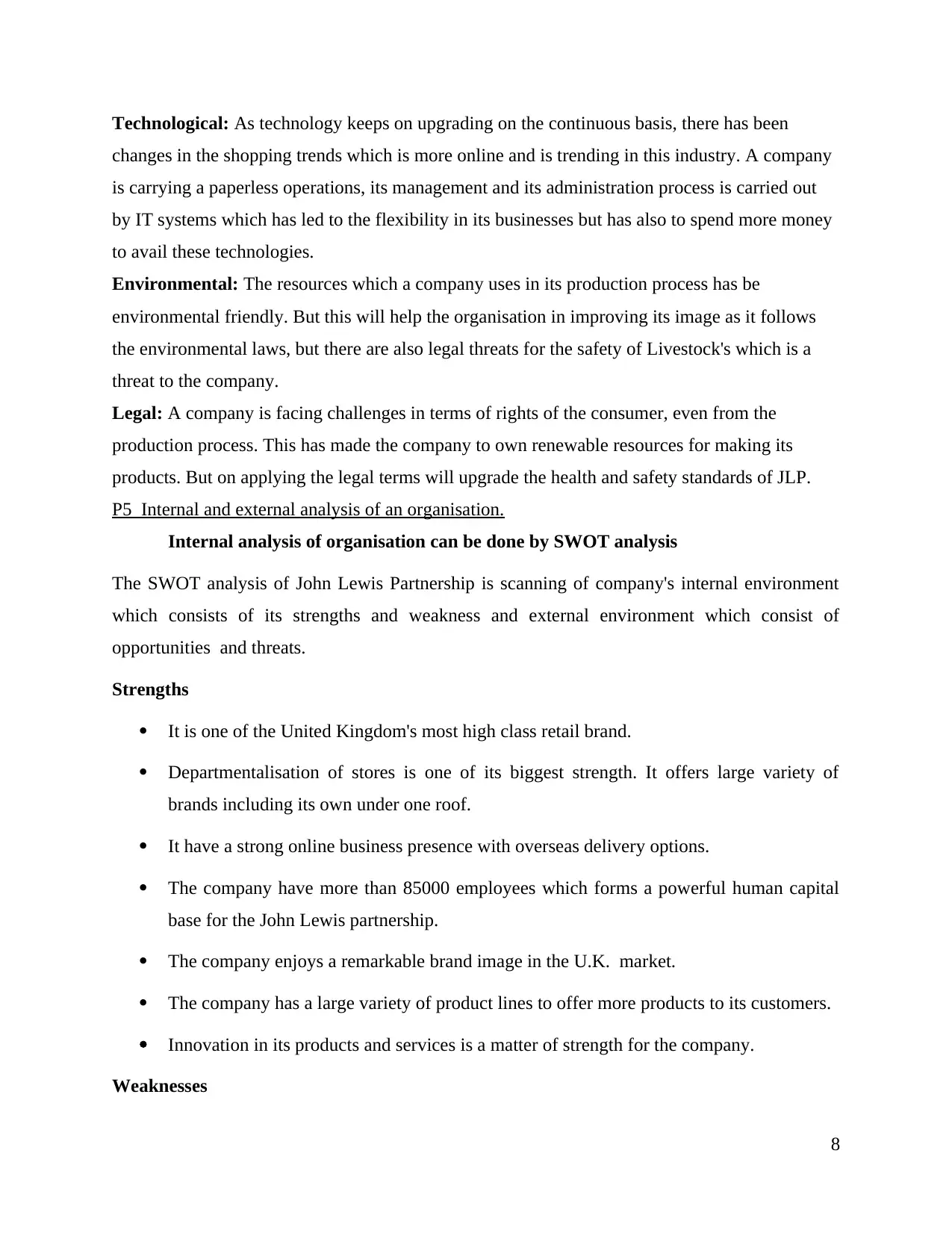
Technological: As technology keeps on upgrading on the continuous basis, there has been
changes in the shopping trends which is more online and is trending in this industry. A company
is carrying a paperless operations, its management and its administration process is carried out
by IT systems which has led to the flexibility in its businesses but has also to spend more money
to avail these technologies.
Environmental: The resources which a company uses in its production process has be
environmental friendly. But this will help the organisation in improving its image as it follows
the environmental laws, but there are also legal threats for the safety of Livestock's which is a
threat to the company.
Legal: A company is facing challenges in terms of rights of the consumer, even from the
production process. This has made the company to own renewable resources for making its
products. But on applying the legal terms will upgrade the health and safety standards of JLP.
P5 Internal and external analysis of an organisation.
Internal analysis of organisation can be done by SWOT analysis
The SWOT analysis of John Lewis Partnership is scanning of company's internal environment
which consists of its strengths and weakness and external environment which consist of
opportunities and threats.
Strengths
It is one of the United Kingdom's most high class retail brand.
Departmentalisation of stores is one of its biggest strength. It offers large variety of
brands including its own under one roof.
It have a strong online business presence with overseas delivery options.
The company have more than 85000 employees which forms a powerful human capital
base for the John Lewis partnership.
The company enjoys a remarkable brand image in the U.K. market.
The company has a large variety of product lines to offer more products to its customers.
Innovation in its products and services is a matter of strength for the company.
Weaknesses
8
changes in the shopping trends which is more online and is trending in this industry. A company
is carrying a paperless operations, its management and its administration process is carried out
by IT systems which has led to the flexibility in its businesses but has also to spend more money
to avail these technologies.
Environmental: The resources which a company uses in its production process has be
environmental friendly. But this will help the organisation in improving its image as it follows
the environmental laws, but there are also legal threats for the safety of Livestock's which is a
threat to the company.
Legal: A company is facing challenges in terms of rights of the consumer, even from the
production process. This has made the company to own renewable resources for making its
products. But on applying the legal terms will upgrade the health and safety standards of JLP.
P5 Internal and external analysis of an organisation.
Internal analysis of organisation can be done by SWOT analysis
The SWOT analysis of John Lewis Partnership is scanning of company's internal environment
which consists of its strengths and weakness and external environment which consist of
opportunities and threats.
Strengths
It is one of the United Kingdom's most high class retail brand.
Departmentalisation of stores is one of its biggest strength. It offers large variety of
brands including its own under one roof.
It have a strong online business presence with overseas delivery options.
The company have more than 85000 employees which forms a powerful human capital
base for the John Lewis partnership.
The company enjoys a remarkable brand image in the U.K. market.
The company has a large variety of product lines to offer more products to its customers.
Innovation in its products and services is a matter of strength for the company.
Weaknesses
8
Paraphrase This Document
Need a fresh take? Get an instant paraphrase of this document with our AI Paraphraser
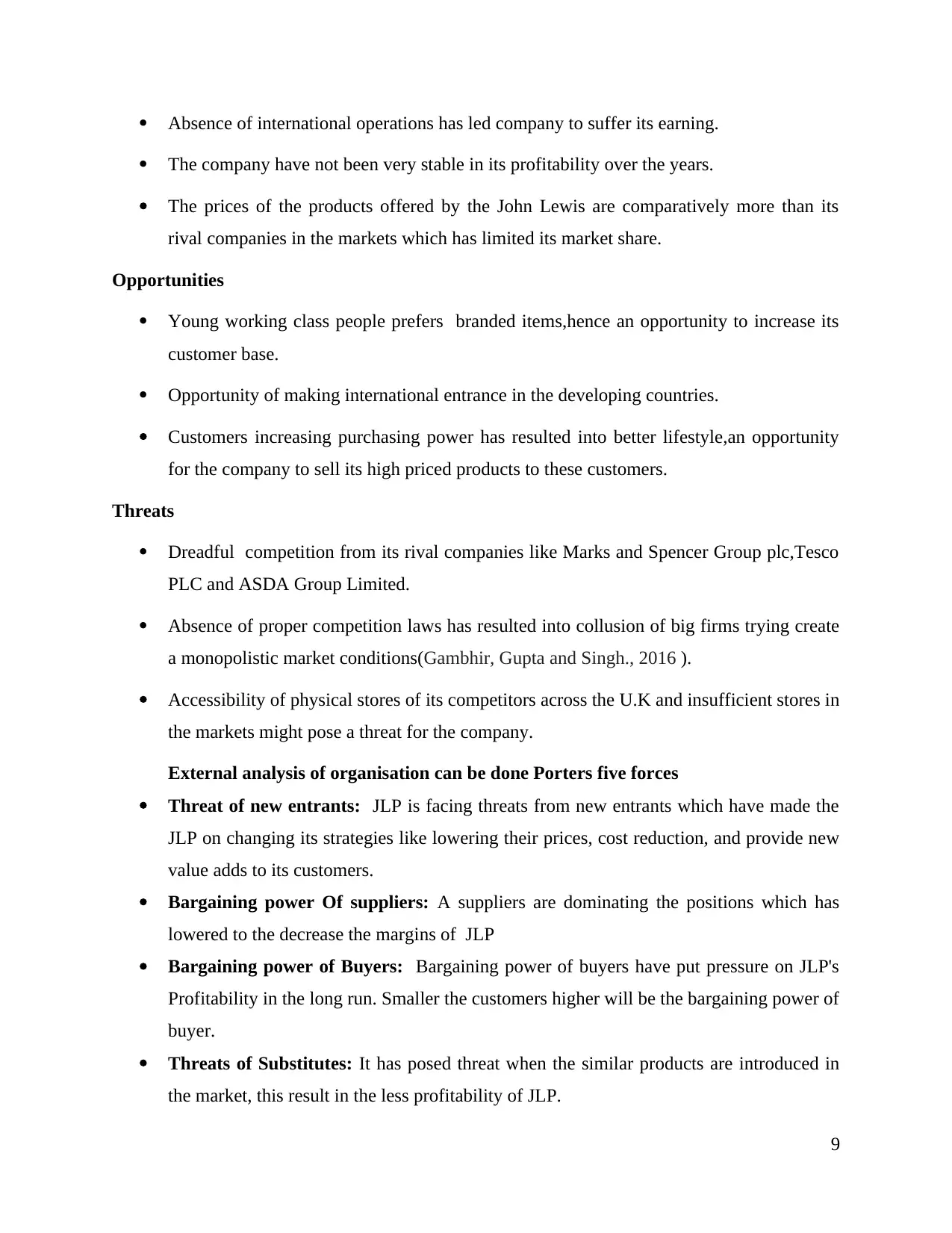
Absence of international operations has led company to suffer its earning.
The company have not been very stable in its profitability over the years.
The prices of the products offered by the John Lewis are comparatively more than its
rival companies in the markets which has limited its market share.
Opportunities
Young working class people prefers branded items,hence an opportunity to increase its
customer base.
Opportunity of making international entrance in the developing countries.
Customers increasing purchasing power has resulted into better lifestyle,an opportunity
for the company to sell its high priced products to these customers.
Threats
Dreadful competition from its rival companies like Marks and Spencer Group plc,Tesco
PLC and ASDA Group Limited.
Absence of proper competition laws has resulted into collusion of big firms trying create
a monopolistic market conditions(Gambhir, Gupta and Singh., 2016 ).
Accessibility of physical stores of its competitors across the U.K and insufficient stores in
the markets might pose a threat for the company.
External analysis of organisation can be done Porters five forces
Threat of new entrants: JLP is facing threats from new entrants which have made the
JLP on changing its strategies like lowering their prices, cost reduction, and provide new
value adds to its customers.
Bargaining power Of suppliers: A suppliers are dominating the positions which has
lowered to the decrease the margins of JLP
Bargaining power of Buyers: Bargaining power of buyers have put pressure on JLP's
Profitability in the long run. Smaller the customers higher will be the bargaining power of
buyer.
Threats of Substitutes: It has posed threat when the similar products are introduced in
the market, this result in the less profitability of JLP.
9
The company have not been very stable in its profitability over the years.
The prices of the products offered by the John Lewis are comparatively more than its
rival companies in the markets which has limited its market share.
Opportunities
Young working class people prefers branded items,hence an opportunity to increase its
customer base.
Opportunity of making international entrance in the developing countries.
Customers increasing purchasing power has resulted into better lifestyle,an opportunity
for the company to sell its high priced products to these customers.
Threats
Dreadful competition from its rival companies like Marks and Spencer Group plc,Tesco
PLC and ASDA Group Limited.
Absence of proper competition laws has resulted into collusion of big firms trying create
a monopolistic market conditions(Gambhir, Gupta and Singh., 2016 ).
Accessibility of physical stores of its competitors across the U.K and insufficient stores in
the markets might pose a threat for the company.
External analysis of organisation can be done Porters five forces
Threat of new entrants: JLP is facing threats from new entrants which have made the
JLP on changing its strategies like lowering their prices, cost reduction, and provide new
value adds to its customers.
Bargaining power Of suppliers: A suppliers are dominating the positions which has
lowered to the decrease the margins of JLP
Bargaining power of Buyers: Bargaining power of buyers have put pressure on JLP's
Profitability in the long run. Smaller the customers higher will be the bargaining power of
buyer.
Threats of Substitutes: It has posed threat when the similar products are introduced in
the market, this result in the less profitability of JLP.
9
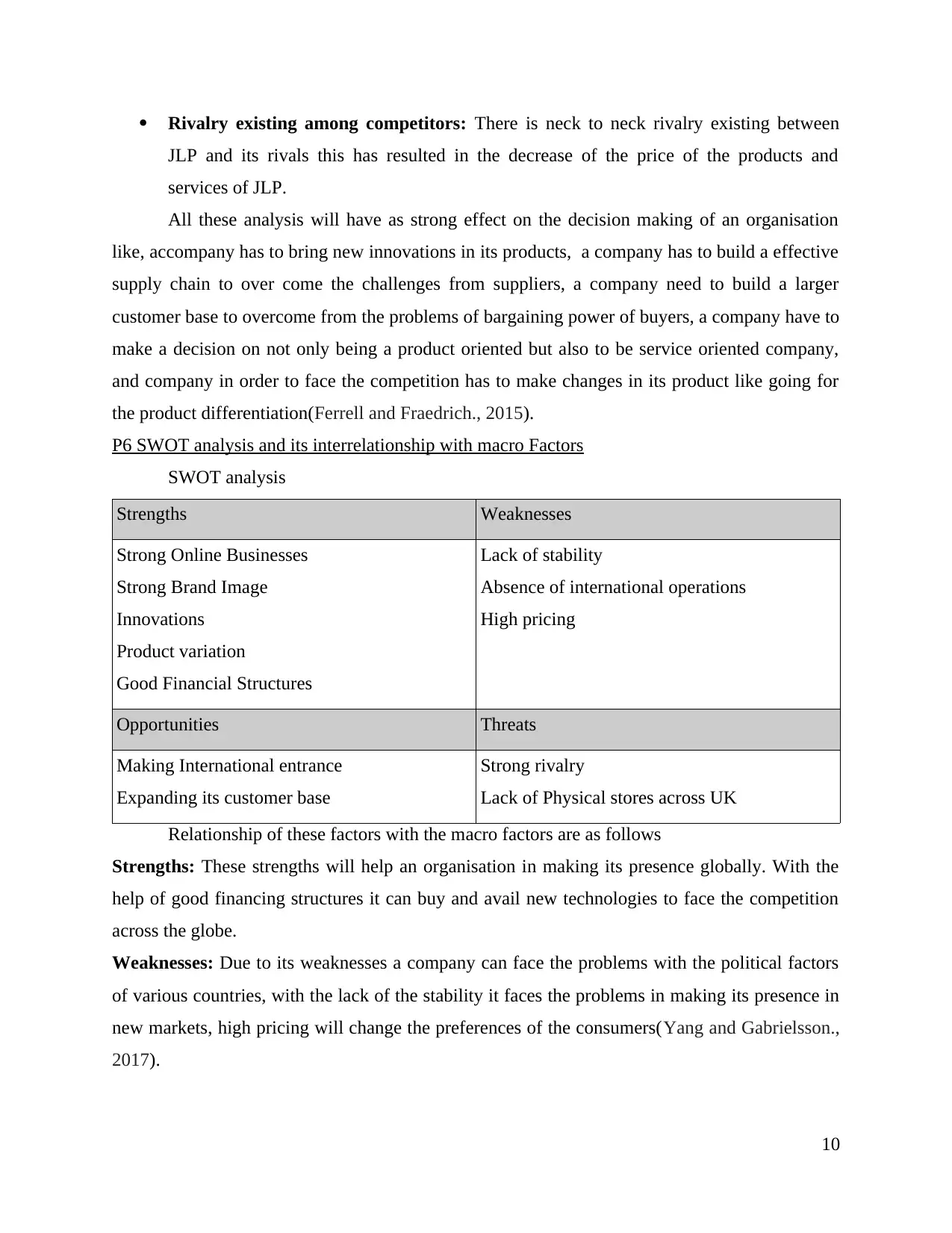
Rivalry existing among competitors: There is neck to neck rivalry existing between
JLP and its rivals this has resulted in the decrease of the price of the products and
services of JLP.
All these analysis will have as strong effect on the decision making of an organisation
like, accompany has to bring new innovations in its products, a company has to build a effective
supply chain to over come the challenges from suppliers, a company need to build a larger
customer base to overcome from the problems of bargaining power of buyers, a company have to
make a decision on not only being a product oriented but also to be service oriented company,
and company in order to face the competition has to make changes in its product like going for
the product differentiation(Ferrell and Fraedrich., 2015).
P6 SWOT analysis and its interrelationship with macro Factors
SWOT analysis
Strengths Weaknesses
Strong Online Businesses
Strong Brand Image
Innovations
Product variation
Good Financial Structures
Lack of stability
Absence of international operations
High pricing
Opportunities Threats
Making International entrance
Expanding its customer base
Strong rivalry
Lack of Physical stores across UK
Relationship of these factors with the macro factors are as follows
Strengths: These strengths will help an organisation in making its presence globally. With the
help of good financing structures it can buy and avail new technologies to face the competition
across the globe.
Weaknesses: Due to its weaknesses a company can face the problems with the political factors
of various countries, with the lack of the stability it faces the problems in making its presence in
new markets, high pricing will change the preferences of the consumers(Yang and Gabrielsson.,
2017).
10
JLP and its rivals this has resulted in the decrease of the price of the products and
services of JLP.
All these analysis will have as strong effect on the decision making of an organisation
like, accompany has to bring new innovations in its products, a company has to build a effective
supply chain to over come the challenges from suppliers, a company need to build a larger
customer base to overcome from the problems of bargaining power of buyers, a company have to
make a decision on not only being a product oriented but also to be service oriented company,
and company in order to face the competition has to make changes in its product like going for
the product differentiation(Ferrell and Fraedrich., 2015).
P6 SWOT analysis and its interrelationship with macro Factors
SWOT analysis
Strengths Weaknesses
Strong Online Businesses
Strong Brand Image
Innovations
Product variation
Good Financial Structures
Lack of stability
Absence of international operations
High pricing
Opportunities Threats
Making International entrance
Expanding its customer base
Strong rivalry
Lack of Physical stores across UK
Relationship of these factors with the macro factors are as follows
Strengths: These strengths will help an organisation in making its presence globally. With the
help of good financing structures it can buy and avail new technologies to face the competition
across the globe.
Weaknesses: Due to its weaknesses a company can face the problems with the political factors
of various countries, with the lack of the stability it faces the problems in making its presence in
new markets, high pricing will change the preferences of the consumers(Yang and Gabrielsson.,
2017).
10
⊘ This is a preview!⊘
Do you want full access?
Subscribe today to unlock all pages.

Trusted by 1+ million students worldwide
1 out of 15
Related Documents
Your All-in-One AI-Powered Toolkit for Academic Success.
+13062052269
info@desklib.com
Available 24*7 on WhatsApp / Email
![[object Object]](/_next/static/media/star-bottom.7253800d.svg)
Unlock your academic potential
Copyright © 2020–2025 A2Z Services. All Rights Reserved. Developed and managed by ZUCOL.

